1988 PONTIAC FIERO brake
[x] Cancel search: brakePage 1326 of 1825
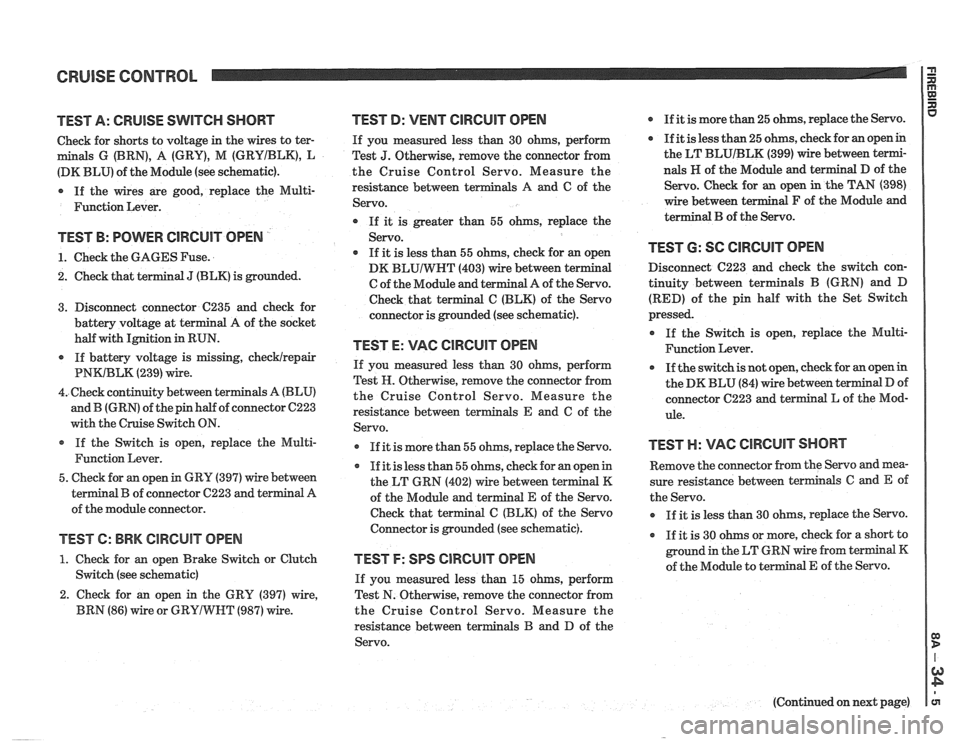
CRUISE CONTROL 13 rn E
TEST A: CRUISE SWITCH SHORT
Check for shorts to voltage in the wires to ter-
m als G (BRN), A (GRY), M (GRYIBLK), L
(DK BLU) of the Module (see schematic).
* If the wires are good, replace the Multi-
Function Lever.
TEST B: POWER ClRCUlT OPEN
1. Check the GAGES Fuse.
2. Check that terminal
J (BLK) is grounded.
3. Disconnect connector
C235 and check for
battery voltage at terminal A of the socket
half with Ignition
in RUN.
* If battery voltage is missing, checklrepair
PNWBLK (239) wire.
4. Check continuity between t
and B (GRN) of the pin half of connector C223
with the Cruise Switch ON.
If the Switch is open, replace the Multi-
Function Lever.
5. Check for an open in GRY (397) wire between
al
B of connector C223 and terminal A
of the module connector.
TEST 6: BRK CIRCUIT OPEN
1. Check for an open Brake Switch or Clutch
Switch (see schematic)
2. Check for an open in the
GRY (397) wire,
BRN
(86) wire or GRYIWNT (987) wire.
TEST D: VENT ClRCUlT OPEN
If you measured less than 30 ohms, perform
Test
J. Otherwise, remove the connector from
the Cruise Control Servo. Measure the
resistance between
terminals A and C of the
Servo.
If
it is greater than 55 ohms, replace the
Servo.
* If it is less than 55 ohms, check for an open
DK
BLUIWHT (403) wire between te
C of the Module and
t
Check that terminal C (BLK) of the Servo
connector is grounded (see schematic).
TEST E: VAC ClRCUlT OPEN
If you measured less than 30 ohms, perform
Test
IF. Otherwise, remove the connector from
the Cruise Control Servo. Measure the
resistance between
t als E and C of the
Servo.
If it is more than 55 ohms, replace the Servo.
If it is less than 55 ohms, check for an open in
the LT GRN (402) wire between t
of the Module and terminal E of the Servo.
Check that terminal C (BLK) of the Servo
Connector is grounded (see schematic).
TEST F: SPS CIRCUIT OPEN
If you measured less than 15 ohms, perform
Test N. Otherwise, remove the connector from
the Cruise Control Servo. Measure the
resistance between terminals
B and D of the
Servo.
r If it is more than 25 ohms, replace the Servo.
* If it is less than 25 ohms, check for an open in
the LT
BLUIBLK (399) wire between termi-
nals
H of the Module and
Servo. Check for an open
wire between
t al F of the Module and
terminal B of the Servo.
TEST 6: SC ClRGUlT OPEN
Disconnect C223 and check the switch con-
tinuity between terminals B (GRN) and D
(RED) of the pin half with the Set Switch
pressed.
* If the Switch is open, replace the Multi-
Function Lever.
If the switch is not open, check for an open in
the DK BLU (84) wire between terminal
D of
connector C223 and te al
L of the
Mod-
ule.
TEST H: VAC CIRCUIT SHORT
Remove the connector from the Servo and mea-
sure resistance between terminals
C and E of
the Servo.
r If it is less than 30 ohms, replace the Servo.
If it is 30 ohms or more, check for a short to
ground in the LT GRN wire from terminal K
of the Module to terminal
E of the Servo.
(Continued on next page)
Page 1327 of 1825

CRUISE CONTROL
(Continued from previous page)
TEST I: RIA CIRCUIT OPEN
Disconnect C223 and check switch continuity
between terminals A (BLU) and C (YEL) of the
pin half of the Cruise Switch in RIA.
0 If the switch is open, replace the Multi-Func-
tion Lever.
If the switch is not open, check for an open in
the
GRYIBLK (87) wire between terminal C
of connector C223 at terminal M of the Mod-
ule.
TEST J: VENT CIRCUIT SHORT
Remove the connector from the Servo and mea-
sure resistance between terminals
A and C of
the Servo.
If it is less than 30 ohms, replace the Servo.
If it is 30 ohms or more, check for a short to
ground in the DK
BLUIWHT wire from ter-
minal C of the Module to terminal A of the
Servo.
TEST K: VSS ClRCUlT OPEN
If the VSS light does not come on, or the volt-
age between terminals A (GRY) and D (BRN)
remains less than 7 volts, check for an open in
the BRN (437) wire or the RED (381) wire from
the Vehicle Speed Sensor Buffer. Refer to page
33-0 for diagnosis of Vehicle Speed Sensor.
TEST L: VSS CIRCUIT SHORT
If the VSS lights does not go off or Battery
voltage remains between ter
and D
(BRN), check for a short to ground on the
BRN (437) wire or the RED (381) wire from the
Vehicle Speed Sensor Buffer. Refer to page 33-0
for diagnosis of Vehicle Speed Sensor.
TEST M: VACUUM SYSTEM
1. Check for a blocked or leaking vacuum
source.
2. If the vacuum source is good, plug the Vac-
uum Release Port and repeat Test
6 of the
Isolation Test.
If the vacuum now holds the throttle open,
replace or repair the Vacuum Release Valve
or the hose to it.
If the test still fails, replace the Cruise Con-
trol Servo.
TEST N: SPS CIRCUIT SHORT
Disconnect the Cruise Control Servo connector
and repeat Test 7 of the Isolation Test.
If the resistance is now over range, replace
the Cruise Control Servo.
If the resistance is still low, find and repair
the short in the TAN wire from terminal F of
the Cruise Control Module to terminal B of
the Cruise Control Servo.
ClRCUlT OPERATION
The Cruise Control System operates a
mechanical linkage to the throttle by means of a
Vacuum Motor. This is a diaphragm moved by
a vacuum applied to one side. A solenoid oper-
ated valve connects the Vacuum Motor to a
Vacuum Tank. Another solenoid valve vents
the vacuum to reduce the suction. The Cruise
Control Module controls the Vacuum Motor
and the throttle by pulsing these solenoid
valves on and off.
One input to the Module is the vehicle speed.
This input comes from the Vehicle Speed Sen-
sor. If the actual speed signal is different from
the speed that was set into and remembered by
the Module, the Module generates pulses to
change the vacuum and return the vehicle to
the set speed. The Vehicle Speed Sensor is
mounted on the Transmission. Other inputs to
the Module are from the Cruise Switch and the
Set Switch. A disengage input to the Module
comes from a switch on the brake pedal. A
sepe-
rate vacuum shut down of the Cruise Control
comes from the Vacuum Release Valve on the
brake pedal.
The two outputs of the Cruise Control Mod-
ule operate the coils of the Vacuum Valve and
the Vent Valve. Both valves are located in the
Cruise Control Servo. These valves move the
throttle be means of the Vacuum Motor. The
Servo Position Sensor
(SPS) coil senses the
position and motion of the Vacuum Motor. It
feeds this information back to the Module to
provide smooth acceleration while the vehicle is
in Cruise Control.
Page 1330 of 1825
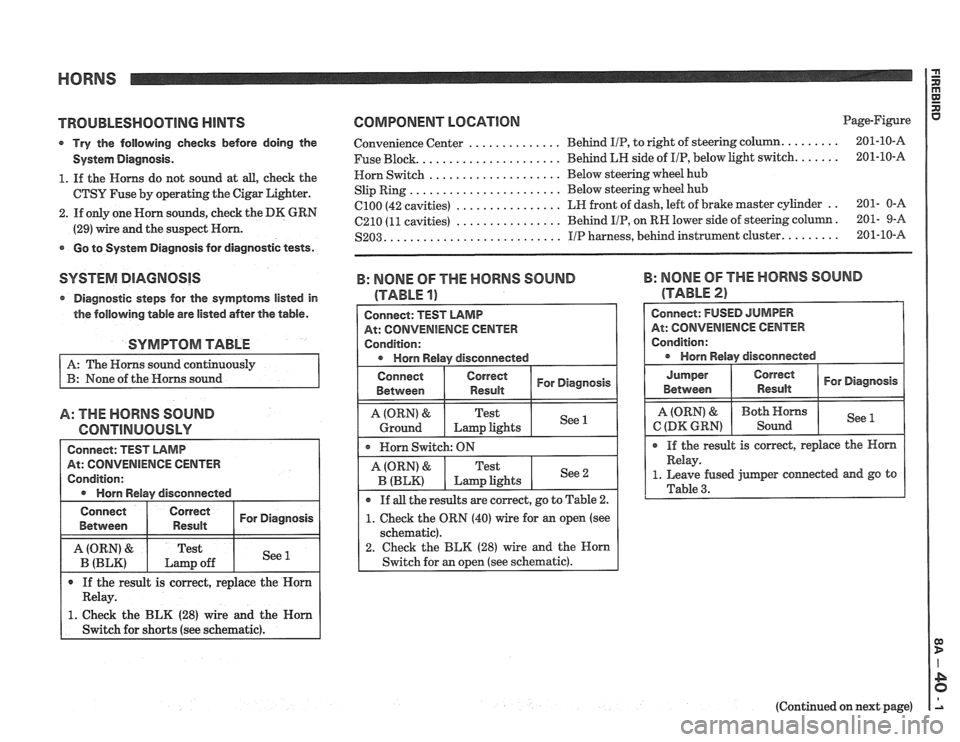
HORNS
TROUBEESHOOTlNG HINTS
Try the following checks before doing the
System Diagnosis.
1. If the Horns do not sound at all, check the
CTSY Fuse by operating the Cigar Lighter.
2. If only one Worn sounds, check the DK GRN
(29) wire and the suspect Horn.
Go to System Diagnosis for diagnostic tests.
SYSTEM DIAGNOSIS
Diagnostic steps for the symptoms listed in
the following table are listed after the table.
SYMPTOM TABLE
A: The Horns sound continuously
B: None of the Horns sound
A: THE HORNS SOUND
GONTlNUOUSLY
COMPONENT LOCATION Page-Figure
.............. Convenience Center Behind IIP, to
right of steering column. ........ 201-10-A
..................... ...... Fuse Block. Behind LH side
of I/P, belour light switch. 201-10-A
.................... Horn Switch Below
steering wheel hub
....................... Slip Ring Below
steering wheel hub
................ el00 (42 cavities) LH front of dash, left of brake master cylinder .. 201- 0-A
................ C210 (11 cavities) Behind IIP, on
RW lower side of steering column. 201- 9-A
.......................... S203. IIP harness, behind instrument cluster. ........ 201-10-8
B: NONE OF THE MORNS SOUND
(TABLE a,
Connect: TEST LAMB
IiENcE CENTER
I Condition:
a Horn Relay disconnected
Connect
Between I ","d::r I For Diagnosis
A (ORN) &
Ground
B: NOME OF THE HORNS SOUND
(TABLE 21
Horn Switch: ON
Jumper
Between
Test
Lamp lights
(Continued on next page)
See 1
See 2 A (ORN) &
B (BLK)
If all the results
are correct, go to Table 2.
1. Cheek the ORN (40) wire for an open (see
schematic).
2. Check the BLK (28) wire and the Horn
Switch for an open (see schematic).
Test
Lmp lights
Page 1333 of 1825
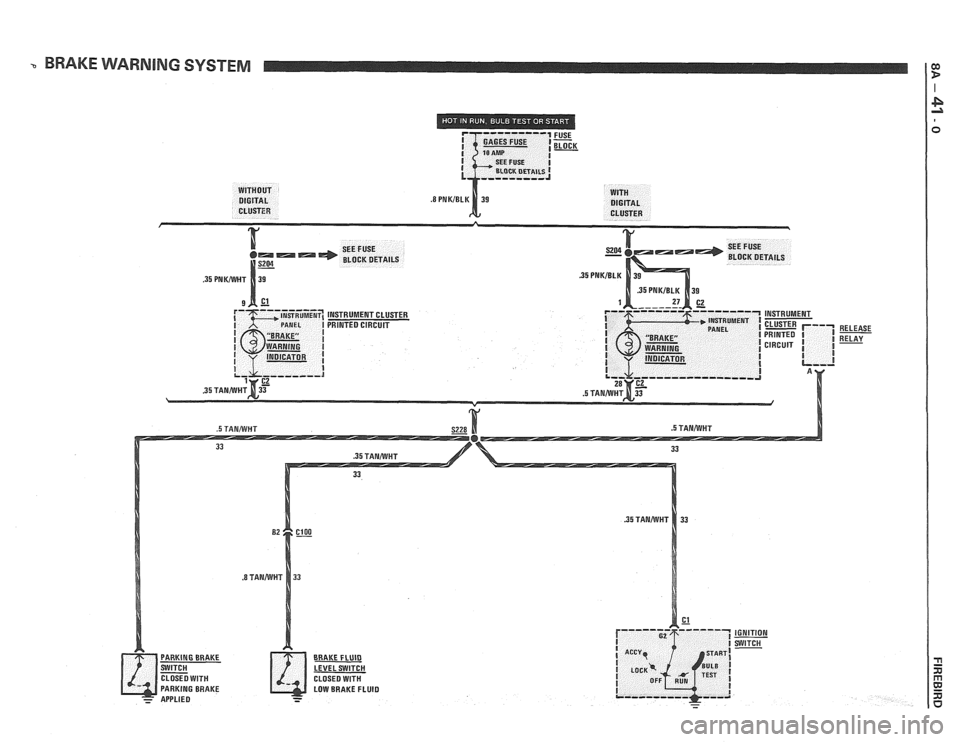
BRAKE WARNING SYSTEM
INSTRUMENT CLUSTER
PRINTED CIRCUIT
.5 TANAIVHT
BRAICE FLUID
LEVEL SWITCH
LOW BRAKE FLUID
RELEASE
RELAY
Page 1334 of 1825

BRAKE VVARNlNG SYSTEM
TROUBLESHOOTING HINTS
0 Try the following checks before doing the
System Diagnosis.
Check the GAGES Fuse and PNKIBLK
(39) wire by observing the VOLTS or
SERVICE ENGINE SOON Indicator with
the Ignition Switch in RUN and the engine
OFF.
0 Go to System Check for a guide to normal
operation.
0 Go to System Diagnosis for diagnostic tests.
SYSTEM CHECK
Use the System Check Table as a guide to
normal operation.
e Refer to System Diagnosis for a list of symp-
toms and diagnostic steps.
SYSTEM CHECK TABLE
RUN position to
BULB TEST
COMPONENT LOCATION Page-Figure
.................. Brake Fluid Level Switch. ......... Below brake fluid reservoir 201-16-A
..................... Fuse Block. Behind
LH side of IIP, below light switch. ...... 201-10-A
................. Ignition Switch. Behind IIP, on
top side of steering column ...... 201- 9-A
Parking Brake Switch.
............ In console, at base of parking brake ........... 201-12-D
................... Release Relay Taped
to IIP harness, behind RH side of IIP. .... 201-13-A
................ (2100 (42 cavities) LR
front of dash, left of brake master cylinder .. 201- 0-A
........................... S204. IIP harness, behind instrument cluster. ........ 201-10-A
.......................... ............... S228. IIP harness, above Fuse Block. 201-10-A
SYSTEM DIAGNOSIS
0 Diagnostic steps for the symptorns listed'in
the following table are listed after the table.
A: BRAKE INDICATOR REMAINS ON
WITH THE
IGNITION SWITCH IN
RUN AND THE PARK BRAKE OFF
(TABLE
1)
SYMPTOM TABLE
A BRAKE Indicator remains on with the
Ignition Switch
in RUN and the park
brake off
B BRAKE Indicator lights with the park
brake applied, but does not light when
brake fluid level is low
C BRAKE Indicator does not light at all
D BRAKE Indicator lights with the Igni-
tion Switch in BULB TEST, but does not
light when the park brake is applied
E BRAKE Indicator lights with the park
brake applied, but does not light when
the Ignition Switch is in BULB TEST
Refer to System Diagnosis when a result is
not normal. Disconnect:
CONNECTOR
At: BRAKE FLUID LEVEL SWITCH
Conditions:
0 Ignition Switch: RUN
0 Park Brake: OFF
Pressure Warning
If the result is correct, refer to Section
5 to
test the Brake Hydraulic System.
Replace the Brake Fluid Level Switch if
the Brake Hydraulic System is OK.
1. Go to Table2.
Page 1335 of 1825
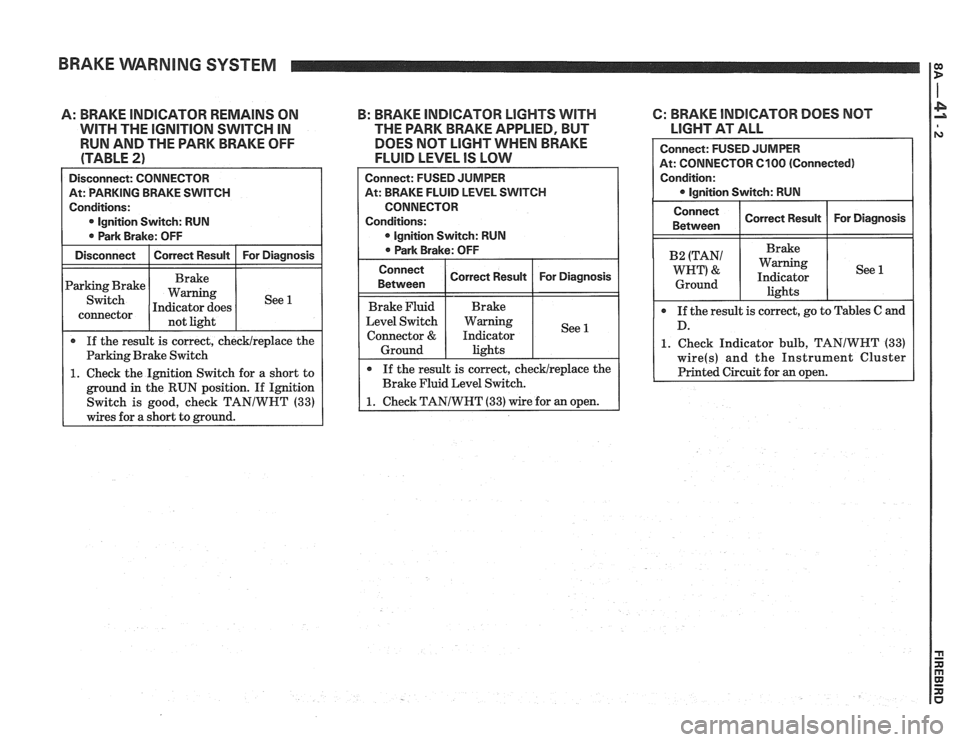
BRAKE WARNING SYSTEM I:
A: BRAKE INDICATOR REMAlNS ON
WITH THE lGNlTlON SWITCH IN
RUN AND THE PARK BRAKE OFF
(TABLE
2)
Disconnect: CONNECTOR I
At: PARKING BRAKE SWITCH
Conditions:
0 lgnition Switch: RUN
0 Park Brake: OFF
Disconnect
I Correct Result I For Diagnosis
Parking Brake
connector not light
If the result is correct, checklreplace the
Parking Brake Switch
1. Check the Ignition Switch for a short to
ground in the RUN position. If Ignition
Switch is good, check TANIWHT
(33)
wires for a short to mound.
B: BRAKE INDICATOR LIGHTS WITH 6: BRAKE INDICATOR DOES NOT
THE PARK BRAKE APPLIED, BUT
LIGHT AT ALL
DOES NOT
LIGHT WHEN BRAKE
FLUID LEVEL IS LOW
1. Check Indicator bulb, TANIWHT (33)
Connect: FUSED JUMPER
At: BRAKE FLUID LEVEL SWITCH
CONNECTOR
Conditions:
lgnition Switch: RUN
0 Park Brake: OFF
Connect
Between
Brake Fluid
Level Switch
Connector
&
Ground
If the result is correct, checklreplace the
Brake Fluid Level Switch.
1. Check TANIWHT (33) wire for an open.
Correct Result
Brake
Warning
Indicator lights
For Diagnosis
See 1
Page 1336 of 1825
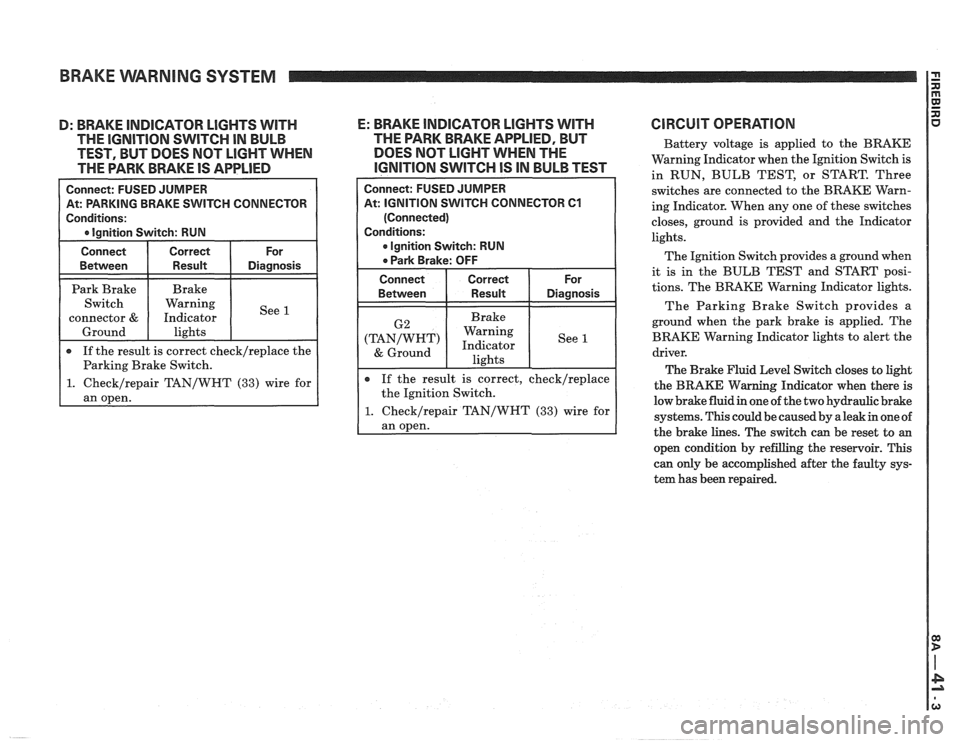
BRAKE WARNING SYSTEM
H CONNECTOR
epair TAN/WHT (33) wire for
D: BRAKE INDICATOR LIGHTS WITH E: BRAKE INDICATOR LlGHTS WITH
THE IGNITION SWITCH IN BULB THE
PARK BRAKE APPLIED, BUT
TEST, BUT DOES NOT
LIGHT WHEN DOES
NOT LIGHT WHEN THE
THE PARK BRAKE IS
APPLIED IGNITION SWITCH IS IN BULB TEST
At: IGNITION SWITCH CONNECTOR 61
If the result is correct, check/replace
the Ignition Switch.
1. Checklrepair TAN/WHT (33) wire for
ClRCUlT OPERATION
Battery voltage is applied to the BRAKE
Warning Indicator when the Ignition Switch is
in RUN, BULB TEST, or START. Three
switches are connected to the BRAKE Warn-
ing Indicator. When any one of these switches
closes, ground is provided and the Indicator
lights.
The Ignition Switch provides a ground when
it is in the BULB TEST and START posi-
tions. The BRAKE Warning Indicator lights.
The Parking Brake Switch provides a
ground when the park brake is applied. The
BRAKE Warning Indicator lights to alert the
driver.
The Brake Fluid Level Switch closes to light
the
BRAKE Warning Indicator when there is
low brake fluid in one of the two hydraulic brake
systems. This could be caused by a leak in one of
the brake lines. The switch can be reset to
an
open condition by refilling the reservoir. This
can only be accomplished after the faulty sys-
tem has been repaired.
Page 1358 of 1825
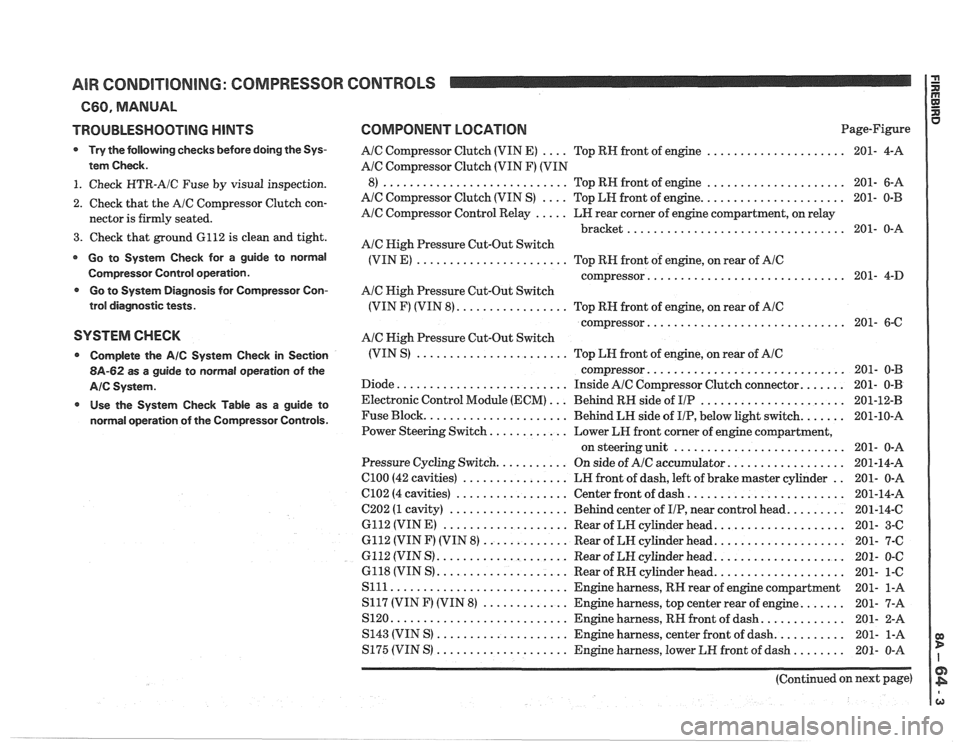
AIR CONDITIONING: COMPRESSOR CONTROLS
660. MANUAL
TROUBLESHOOTING
HINTS
Try the following checks before doing the Sys-
tem Check
.
1 . Check HTR-A/C Fuse by visual inspection .
2 . Check that the A/C Compressor Clutch con-
nector is firmly seated
.
3 . Check that ground 6112 is clean and tight .
Go to System Check for a guide to normal
Cornpressor Control operation
.
Go to System Diagnosis for Compressor Con-
trol diagnostic tests
.
SYSTEM CHECK
Complete the AIC System Check in Section
8A-62 as a guide to normal operation of the
AIC Systern .
Use the System Check Table as a guide to
normal operation of the Compressor Controls
.
COMPONENT LOCPaTlON Page-Figure
.... ..................... AIC Compressor Clutch (VIN E)
Top RH front of engine 201-
4-A
Ale Compressor Clutch (VIN F) (VIN
..................... ............................ 8) Top RH front of engine 201- 6-A
.... ...................... AlC Compressor Clutch (VIN S)
Top LH front of engine 201- 0-B
..... AIC Compressor Control Relay
LH rear corner of engine compartment. on relay
................................. bracket 201- 0-A
A/C High Pressure Cut-Out Switch
....................... (VIN E)
Top RH front of engine. on rear of AIC
.............................. compressor 201- 4-D
Ale Nigh Pressure Cut-Out Switch
................. (VIN F) (VIN 8) Top RN front of engine. on rear of AIC
.............................. compressor 201- 6-C
AIC High Pressure Cut-Out Switch
....................... (VIN S)
Top LH front of engine. on rear of AIC
.............................. compressor 201- 0-B
Diode
.......................... Inside AIC Compressor Clutch connector ....... 201- 0-B
Electronic Control Module (ECM)
... Behind RH side of I/P ...................... 201-12-B
Fuse Block
...................... Behind LH side of IIP. below light switch ....... 201-10-A
............ Power Steering Switch
Lower LR front corner of engine compartment.
.......................... on steering unit 201- 0-A
.................. Pressure Cycling Switch ........... On side of AlC accumulator 201-14-A
.. el00 (42 cavities) ................ LH front of dash. left of brake master cylinder
201- 0-A
........................ 6102 (4 cavities) ................. Center front of dash 201-14-A
......... C202 (1 cavity) .................. Behind center of IIP. near control head
201-14-C
6112 (VINE)
................... Rear of LH cylinder head .................... 201- 3-C
6112 (VIN F) (VIN 8)
............. Rear of LH cylinder head .................... 201- 7-C
G112 (VIN
S) .................... Rear of LH cylinder head .................... 201- 0-C
6118 (VIN S) .................... Rear of RH cylinder head .................... 201- 1-C
S111 ........................... Engine harness. RN rear of engine compartment 201- 1-A
S117 (VIN
F) (VIN 8) ............. Engine harness. top center rear of engine ....... 201- 7-A
S120
........................... Engine harness. RH front ofdash ............. 201- 2-A
........... S143 (VIN S) .................... Engine harness. center front of dash
201- 1-A
S175 (VIN S) .................... Engine harness. lower LH front of dash ........ 201- 0-A
(Continued on next page)